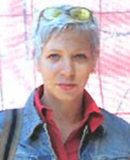|

Petra Gemeinboeck is an architect and media
artist, currently based in Sydney, Australia, where she is
an Assistant Professor of Digital Media at the University
of Sydney. Her artistic practice and theoretical research
bring together the fields of architecture, computer science,
media art and visual culture. In her works Petra creates scenarios
of encounter in which spatial boundaries of the physical,
the virtual, the social and the subjective become perforated
and hybridized.
Her interactive installations and virtual
environments have been exhibited internationally at venues
such as Archilab 2004, Orléans, France, the Ars Electronica
Center, Linz, Austria, the Museum of Contemporary Art Chicago,
USA, and the InterCommunication Center, Tokyo, Japan and have
been featured in magazines such as ARCHIS and Computer Graphics
World. Petra has published widely on the interrelations of
physical and virtual spaces and issues of embodied negotiation
in virtual environments.
Petra's
doctoral thesis ‘Negotiating the Virtual: Inhabiting Architectures
of Emergence and Remoteness,’ completed at the Vienna University
of Technology, Austria, is concerned with the conditions of
a virtual reality, in which the virtual does not simulate
another reality, but unfolds its own reality in the relationship
with the temporary inhabitant. She received her Master of
Fine Arts at the Electronic Visualization Laboratory, University
of Illinois at Chicago, IL, USA and also has a master’s degree
in architecture from the University of Stuttgart, Germany.
|
|
Petra Gemeinboeck
Awarded Summer 2005 Residency
New Media Artist and Architect
petra@arch.usyd.edu.au
Impossible Geographies
01: Memory
<Impossible
Geographies>, a collaboration with Mary Agnes Krell,
presents a series of interactive
and generative urban interventions:
01 <Memory>, selected
for the Do While Residency is an installation whose
sensorial extensions become the fluid virtual boundaries of
a memory space. 02 <Urban
Fictions> , currently in progress,
creates a series of networked incidents,
embedded into the urban fabric.
Both, the memory geography and the network
of 'urban chinese whispers,' build on the conceptual
ground of <Maya-Veil
of Illusion>, a tele-immersive installation,
spanning a fluid passage of intereference between two remote
sites.
The boundaries between the physical and
the virtual in these artworks constitute along the participant’s
body, through a spatio-temporal leakage or in the multitude
of unstable and conflicting urban geographies. And
yet each of them is
concerned with the inhabitation of a pierced reality in which
the physical and virtual are inseparably intertwined.
| |



